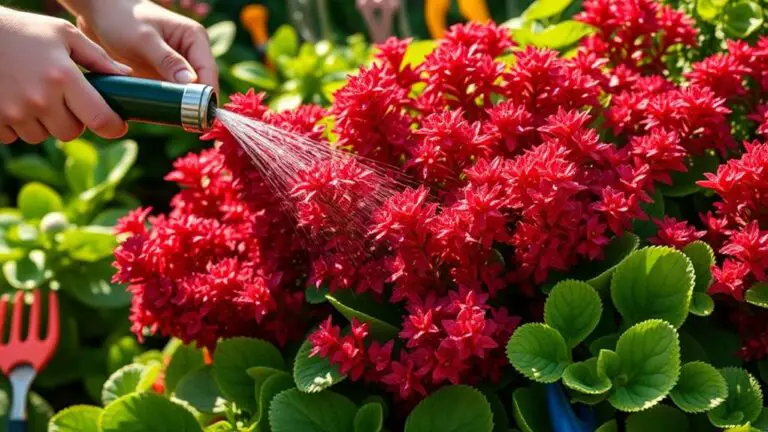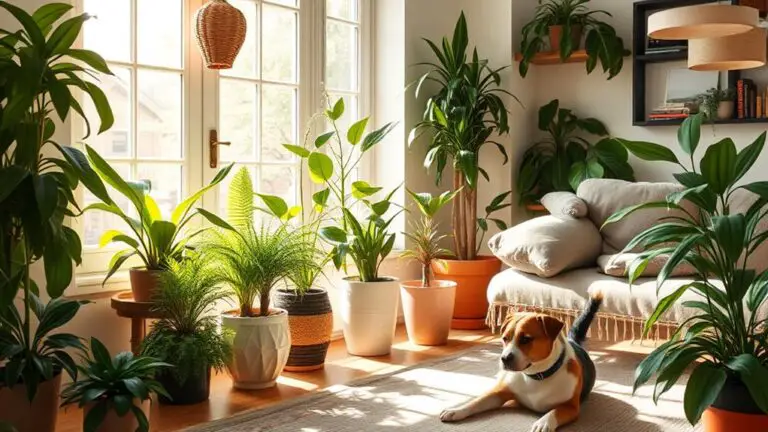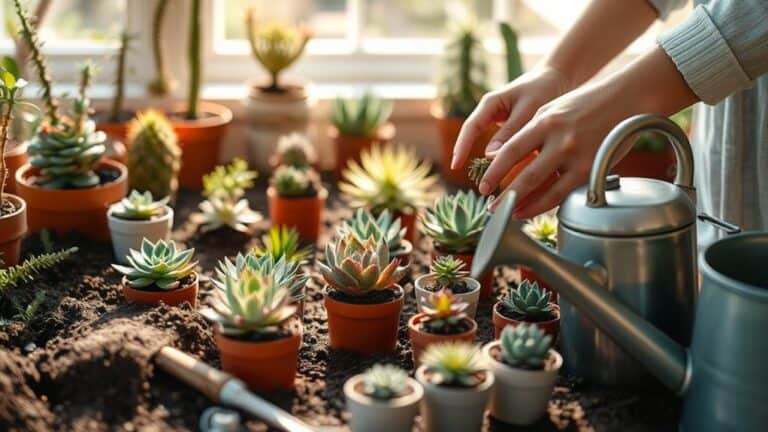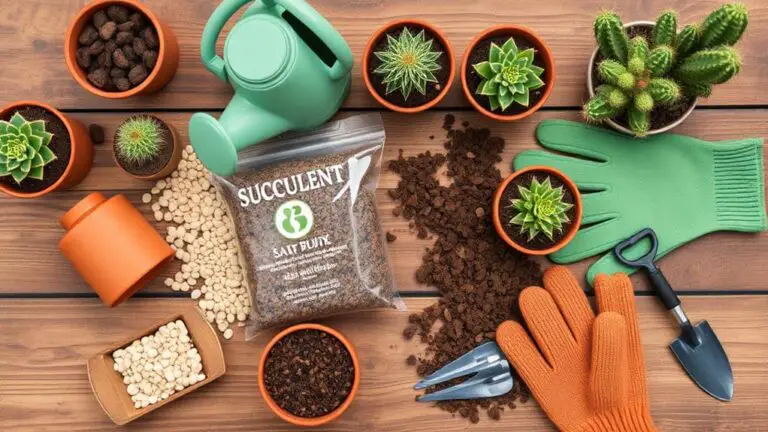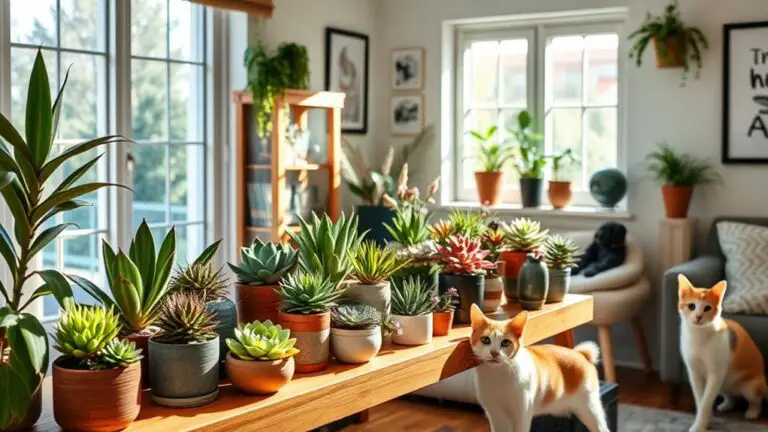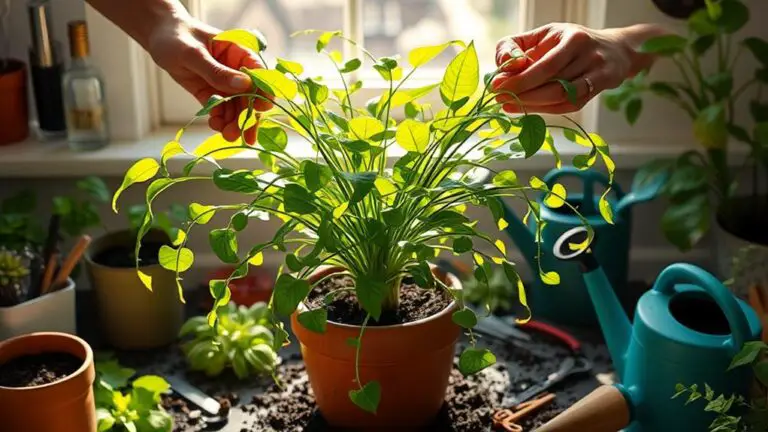The 10 Most Beautiful Flowering Succulents for Your Garden
When planning your garden, considering the 10 most beautiful flowering succulents can transform your space with minimal effort. You'll find the Hardy Ice Plant with its vibrant hues and the Christmas Cactus that blooms in winter particularly enchanting. But that's just the beginning; each succulent on this list brings unique charm and practicality, from the drought-resistant Prickly Pear to the exotic Living Stones. Curious about which other stunning and low-maintenance options can elevate your garden? Let's explore the rest and discover how they can fit into your gardening plans.
Hardy Ice Plant
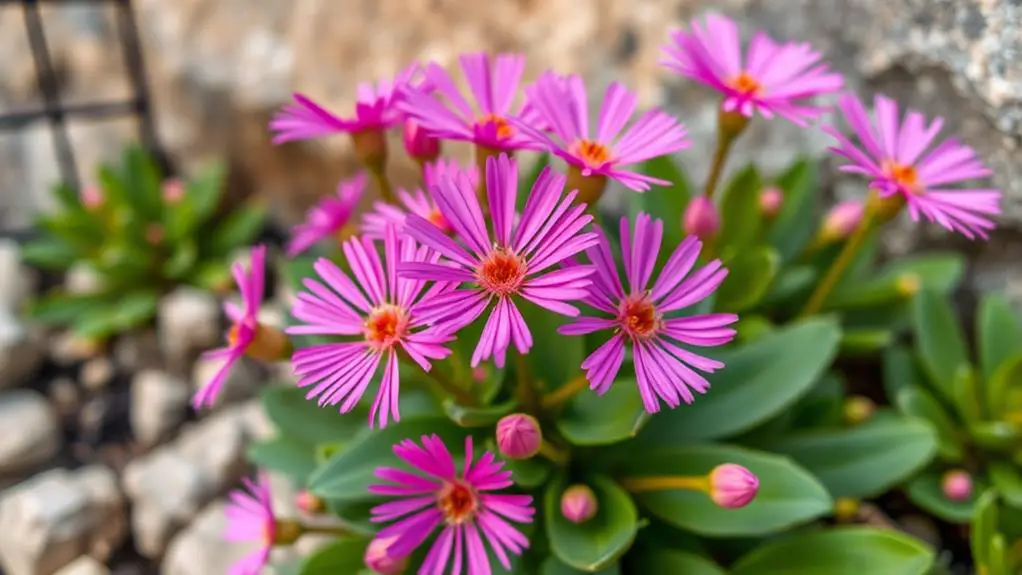
The Hardy Ice Plant, also known as Delosperma, is a vibrant addition to any garden. This colorful succulent thrives in Hardiness Zones 5-10 and loves bright light. You'll notice it prefers sunny, well-drained sites for ideal growth.
It produces stunning daisy-like flowers that bloom all summer, creating a vibrant display in your garden. The flowers' colors range from pink and purple to yellow and white, adding a splash of color wherever you plant them.
One of the best things about the hardy ice plant is its drought-tolerant nature. Once established, it requires minimal watering, making it perfect for low-maintenance landscapes and rock gardens. Just make sure it doesn't sit in wet conditions during winter, as it can suffer. If it does experience winter moisture stress, consider replanting it in spring for the best results.
Besides its beauty, the hardy ice plant serves as an effective ground cover. It quickly spreads to provide erosion control and visual interest in sunny areas.
With its bright light requirements and range of colors, the hardy ice plant is a fantastic choice for any gardener looking for both beauty and practicality.
Stapelia
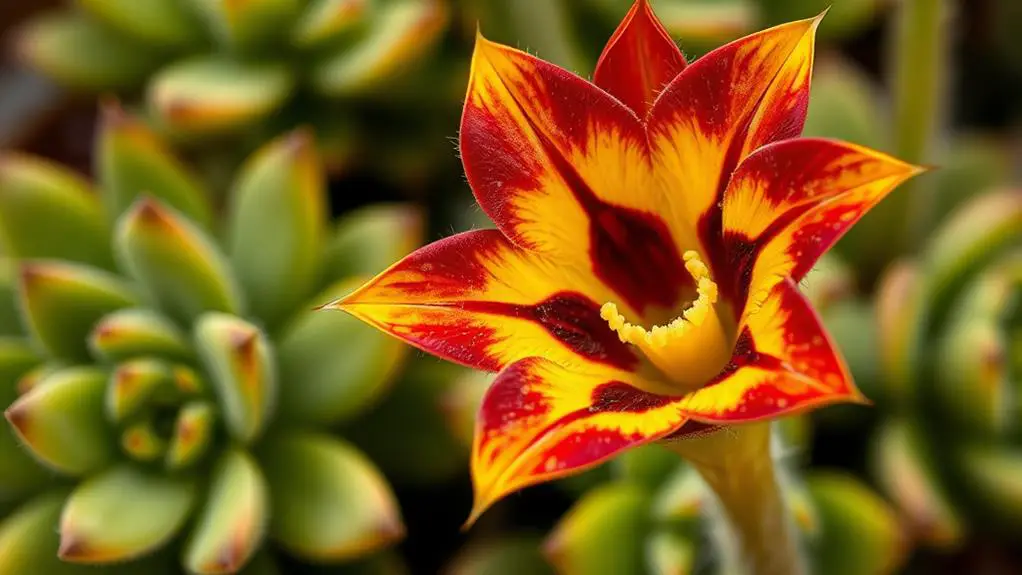
Known for its unique and striking appearance, Stapelia, commonly referred to as Carrion Flower, makes an intriguing addition to any garden. This succulent plant that grows large, often foul-smelling flowers can truly stand out. These flowers can range in size from less than 1 inch to an impressive 8 inches wide. You'll find them in alluring colors like near-black, red, and cream, adding a bold statement to your garden.
Stapelia thrives in bright light and requires well-draining soil, preferring warm, dry conditions for ideal growth. If you can provide these conditions, your plant will flourish. Since Stapelia is native to Africa, it's adapted to sunny, arid environments. Make sure to place your plant where it gets plenty of sunlight but avoid overwatering, as it could harm your succulent.
One thing to note about Stapelia is its strong odor when it blooms. The smell attracts flies for pollination, so it's best to keep it outdoors during this time to avoid the scent indoors.
Despite this, its architectural beauty and exotic appearance make it an intriguing addition to your succulent collection. You'll surely enjoy having this unique plant in your garden.
Christmas Cactus
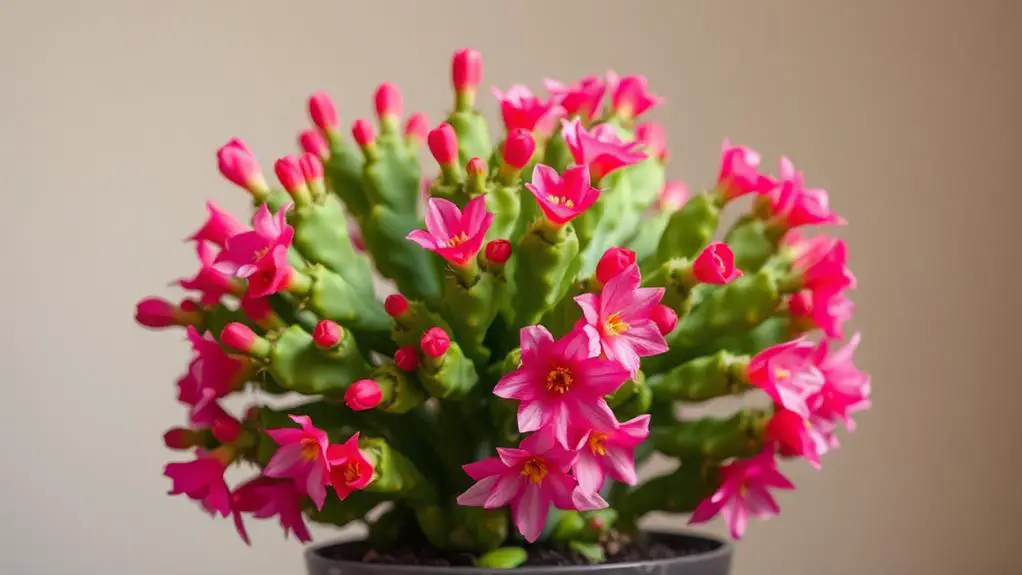
The Christmas Cactus is a perfect choice if you want colorful flowers during the holiday seasons.
Its vibrant blooms come in shades like pink, white, red, orange, and gold, adding a festive touch to your home.
Plus, it's easy to care for, needing indirect sunlight and a bit of darkness to thrive, making it great for beginners.
Blooming Holiday Seasons
During the festive season, nothing brightens up your home quite like a blooming Christmas Cactus. This delightful succulent, with its vibrant pink flowers, is perfect for adding a touch of nature's beauty to your holiday décor. Unlike many other succulents that thrive in direct sunlight, the Christmas Cactus prefers bright indirect light, making it ideal for indoor settings with moderate lighting.
To get your Christmas Cactus blooming in time for the holidays, you need to simulate its natural conditions. It requires about 12-14 hours of darkness each night for several weeks before you expect it to bloom. This period of darkness helps trigger the flowering process, ensuring that your plant produces stunning blooms right when you want them most.
The Christmas Cactus is relatively low-maintenance and can bloom annually with minimal care. It comes in a variety of colors besides pink, including white, red, orange, and gold, offering a spectrum of festive hues to brighten your home.
Colorful Festive Flowers
As the festive season approaches, the Christmas Cactus stands out with its array of colorful blooms, transforming any indoor space into a vibrant holiday haven. This delightful plant showcases vibrant flowers in pink, white, red, orange, and gold, making it a perfect addition to your holiday decor. Unlike most succulents, it thrives in indirect sunlight, so you can place it just about anywhere in your home.
One of the best things about the Christmas Cactus is that it requires little care. All it needs is moderate watering and well-drained soil to thrive. This means you won't have to worry about complicated watering schedules or special soil mixes. Just give it some love and it will reward you with stunning blooms year after year.
Here's a quick overview to help you remember key points:
| Feature | Details |
|---|---|
| Bloom Colors | Pink, white, red, orange, gold |
| Light Requirements | Indirect sunlight |
| Care Level | Minimal (moderate watering) |
The Christmas Cactus can live for decades with proper care and can be easily propagated through cuttings. Its beautiful pink blooms and other colorful festive flowers bring cheer and warmth to any indoor space during the winter months.
Easy Care Tips
Caring for a Christmas Cactus can be a breeze if you follow a few simple guidelines. This plant is easy to grow indoors and needs little care, making it perfect for bright, indoor spaces.
To guarantee your Christmas Cactus thrives and its flowers bloom vibrantly, here are some easy tips:
1. Light and Water: Place your cactus in a spot with indirect sunlight. It loves bright spaces but avoid direct sun, which can scorch the leaves.
Water it only when the top inch of soil feels dry to prevent root rot.
2. Encouraging Blooms: About six weeks before you want your cactus to flower, give it 12-14 hours of darkness each night. This helps trigger the blooming process, so your plant is adorned with beautiful flowers during Christmas, Easter, or Thanksgiving.
3. Long-Term Care: Christmas Cacti can live for decades. They often become family heirlooms, so treat yours with care.
Repot it every few years and trim it if necessary to keep it healthy and vibrant.
Prickly Pear

When you're looking to add a splash of color to your garden with minimal fuss, the Prickly Pear, or Opuntia, is a stellar choice. This plant features vibrant flowers that bloom in shades of pink, yellow, or orange, making it a colorful addition to any garden.
Prickly Pear thrives in full sun, which means it loves bright, direct sunlight all day long. It's perfect for sunny spots in your yard.
One thing to keep in mind is that Prickly Pear is covered in sharp spines. These spines can be painful if touched, so it's important to handle the plant with care. Wearing gloves when working with it is a good idea.
Despite its prickly nature, the Prickly Pear is quite tough. It grows well in hot, dry conditions and doesn't need a lot of water, making it ideal for xeriscaping.
Not only do the flowers add beauty, but they also attract pollinators like bees, which help your garden thrive.
Just remember, all parts of the plant are toxic if eaten, and its sap can irritate your skin. So, enjoy its beauty, but handle with care.
Living Stones
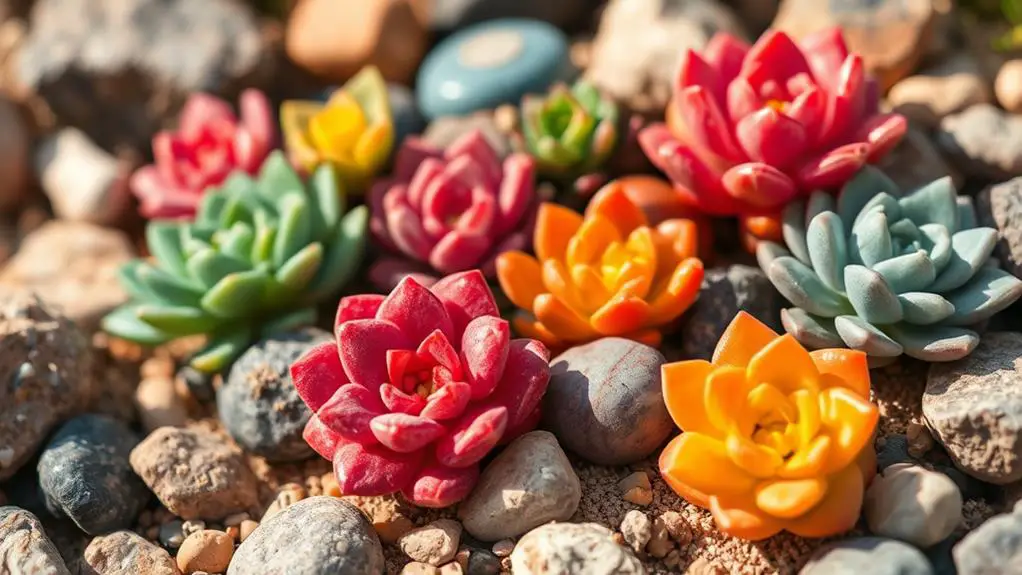
Living Stones, or Lithops, are fascinating succulents that look like pebbles, blending seamlessly into their surroundings.
These unique plants are perfect if you want a garden that stands out while being easy to care for. Native to Southern Africa, Lithops thrive in bright, direct sunlight and require minimal water, showcasing excellent drought tolerance.
Their remarkable camouflage helps them survive in harsh environments, making them a resilient addition to any garden.
What makes Living Stones even more special are their vibrant flowers. These small, colorful blooms emerge from the split in the plant, adding a splash of color to your garden. You can find them in shades of white, orange, yellow, or pink.
Here's why you should consider adding Lithops to your collection:
- Low Maintenance: Lithops require very little water, making them perfect for those who prefer low-maintenance gardening.
- Unique Appearance: Their stone-like look adds a distinctive element to rock gardens or succulent collections.
- Vibrant Flowers: Despite their minimalistic appearance, they surprise you with bright, colorful flowers.
Hoya
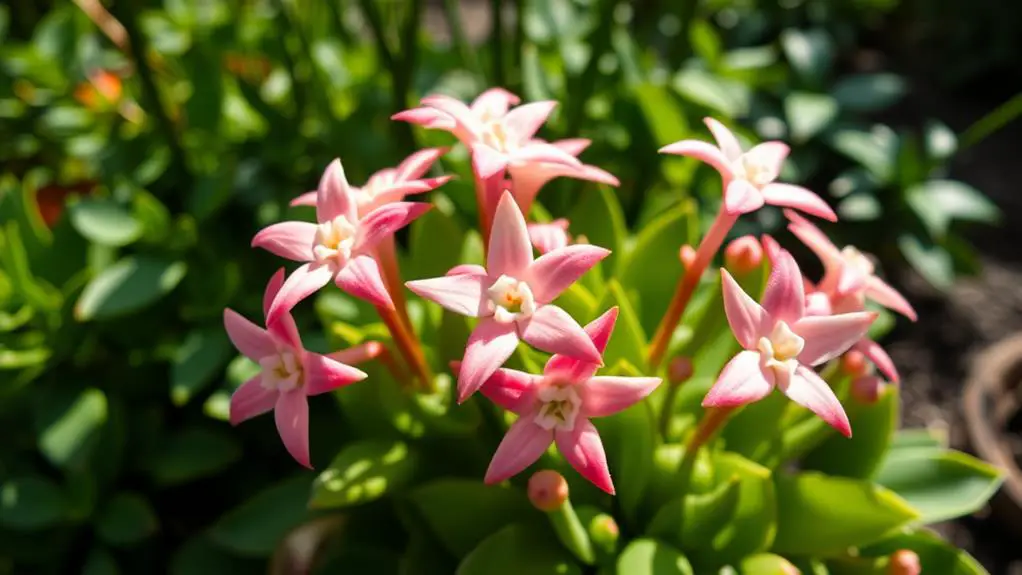
Though often overshadowed by more common succulents, the Hoya, or wax plant, offers a unique blend of beauty and ease of care that makes it a stellar addition to any garden. Hoya plants feature thick, pliable leaves and thrive in bright indirect light, making them perfect for those spots in your home that get some sun but not too much. They require infrequent watering, so you won't need to worry about them too often, making them a low-maintenance choice.
One of the most delightful aspects of the Hoya is its sweetly fragrant blooms. These blooms become more abundant as the plant ages, often after five years or more. The flower clusters are truly a sight to behold, usually forming star-shaped patterns in various colors. This not only adds visual interest but also a pleasant aroma to your garden space.
Here's a quick guide to help you understand the essential care for your Hoya:
| Aspect | Description | Notes |
|---|---|---|
| Light | Bright indirect light | Avoid direct sun |
| Watering | Infrequent | Let soil dry out between waterings |
| Zones | 10 to 12 | Ideal for warmer climates |
| Blooms | Sweetly fragrant, star-shaped | More blooms in older plants |
Adding a Hoya to your collection can bring both beauty and ease to your gardening experience.
Kalanchoe

Kalanchoe blossfeldiana, a dazzling succulent, thrives in hardiness Zones 10 to 12 and boasts vibrant clusters of flowers that can last for months with minimal care.
You'll love the range of colors, from red and orange to yellow and pink, making it a standout in any garden or container.
One of the great things about Kalanchoe is its easy maintenance. This drought-tolerant plant prefers well-draining soil, so you won't have to worry much about overwatering.
Just make sure it gets enough light, and you'll enjoy its beautiful blooms.
Here's how to get the best out of your Kalanchoe:
- Light Requirements: Place your Kalanchoe in a spot where it can get plenty of sunlight, but avoid direct afternoon rays which can be too intense.
- Bloom Initiation: For those vibrant blooms, remember it's a short-day plant. It needs 6 to 11 weeks of darkness to start flowering.
- Soil and Watering: Use well-draining soil to prevent root rot. Water sparingly, letting the soil dry out between waterings.
You'll often find Kalanchoe in grocery store floral sections, perfect for both novice and experienced gardeners.
Enjoy the cheerful beauty it brings to your home!
Crown of Thorns

Kalanchoe's vibrant hues are a delight, but let's explore another intriguing succulent that adds both color and character to your garden: the Crown of Thorns (Euphorbia milii). This hardy succulent thrives in Zones 9 to 11 and boasts vibrant blooms year-round with minimal maintenance. Its colorful bracts come in red, pink, yellow, and white, offering continuous beauty.
The Crown of Thorns prefers bright light to produce its stunning flowers. This makes it a perfect houseplant if you have a sunny spot indoors. Just be cautious of its thorny stems and the irritant latex sap it contains. Wearing gloves while handling it is a good idea, especially if you have pets or children.
Here's a quick overview of the Crown of Thorns:
| Feature | Description |
|---|---|
| Hardiness Zones | 9 to 11 |
| Bloom Colors | Red, Pink, Yellow, White |
| Light Preference | Bright light |
| Indoor/Outdoor Suitability | Both, ideal as a houseplant |
| Maintenance | Minimal, with continuous vibrant blooms |
Moreover, the plant is widely hybridized, resulting in unique cultivars with a variety of flower colors and forms. This makes the Crown of Thorns an exciting addition to any garden, offering both visual appeal and versatility.
Orchid Cactus

The Orchid Cactus, known scientifically as Epiphyllum, is an enchanting addition to any garden, especially when placed in hanging baskets.
As one of the most striking flowering succulents, it produces large, vibrant flowers that can reach up to 12 inches in diameter. You'll love the array of colors, from white and orange to yellow and pink, that burst into bloom.
To guarantee your Orchid Cactus thrives, follow these essential tips:
- Light: Place it where it receives filtered sunlight. Direct sun can scorch its leaves, so a spot with indirect light is best.
- Soil: Use well-draining soil to prevent root rot. Allow the soil to dry out between waterings.
- Water: Maintain humidity by misting the plant daily. This helps mimic its natural tropical environment.
Moss Rose
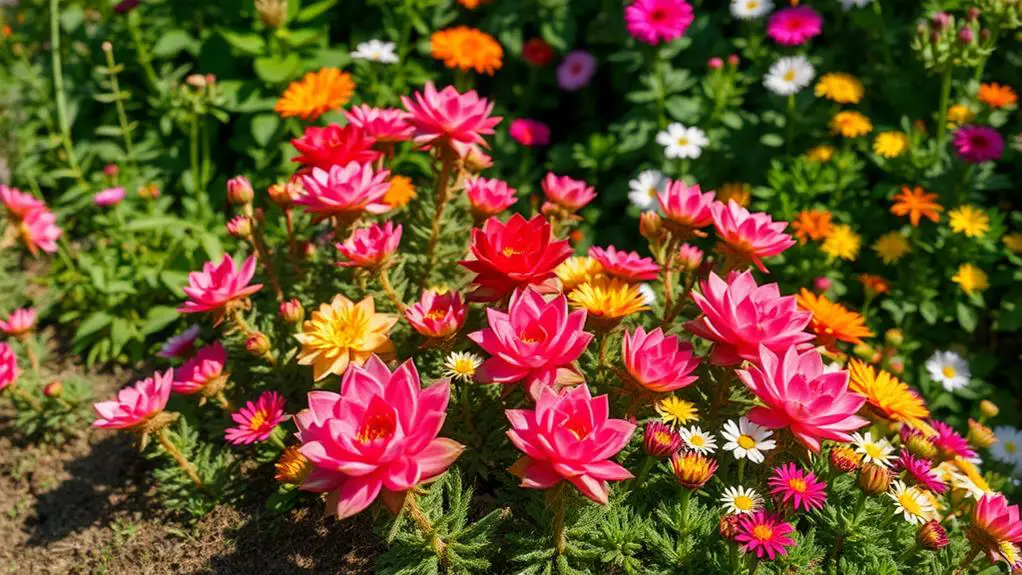
Moss Rose, or Portulaca, is perfect for adding vibrant summer blooms to your garden, especially in hot and dry areas.
It's drought-tolerant and works well as a groundcover, making your garden look lush with minimal effort.
Plus, it's easy to maintain, requiring little watering once established, so you can enjoy its cheerful colors without much hassle.
Vibrant Summer Blooms
During the height of summer, Portulaca, also known as Moss Rose, bursts into a riot of vibrant blooms, making it a standout in any garden.
These vibrant flowers come in saturated colors like hot pink, coral, and yellow, creating cheerful displays that brighten up your outdoor space. Moss Rose is a low-growing succulent that thrives in full sun, making it perfect for hot, dry areas.
To fully appreciate the beauty and ease of Moss Rose, consider these points:
- Full Sun: Moss Rose loves basking in the sun. Plant it in a spot where it gets at least six hours of full sun daily.
- Minimal Watering: Once established, this plant requires minimal watering. It's perfect if you want a low-maintenance garden.
- Continuous Blooms: Throughout the summer months, Moss Rose will reward you with continuous color, keeping your garden lively and vibrant.
Moss Rose is easy to maintain, making it a fantastic choice for both novice and experienced gardeners.
You can even propagate it from seeds, ensuring you have plenty to fill your garden beds and containers.
Drought-Tolerant Groundcover
Looking to add a resilient and vibrant groundcover to your garden? Moss Rose, also known as Portulaca, is the perfect choice for you. This low-growing succulent thrives in Hardiness Zones 3-9 as an annual and Zones 10-11 as a perennial, making it versatile for various climates. Its cheerful, vibrant flowers bloom in hot pink and coral shades throughout the summer, creating a stunning visual display.
Moss Rose is incredibly drought-tolerant, which means it loves hot, sunny, and dry areas. It's an excellent option for xeriscaping and water-wise gardens. You won't need to worry about constant watering; this plant is happy with just occasional hydration.
For Moss Rose to flourish, plant it in well-drained soil. This guarantees that the roots don't sit in water and rot. Because it's low-growing, Moss Rose makes an excellent groundcover, spreading out to fill spaces with its bright blooms.
It's not only beautiful but also practical, covering bare spots in your garden effectively. Plus, it attracts pollinators, adding even more life to your garden.
With Moss Rose, you'll have a gorgeous, low-maintenance, and drought-tolerant groundcover to enjoy all summer long.
Easy Garden Maintenance
Maintaining your garden becomes a breeze with Moss Rose. This flowering succulent, also known as Portulaca, is perfect for those looking to create low maintenance gardens. It thrives in full sun and is drought-tolerant, meaning it requires minimal watering and can handle hot, dry conditions with ease.
Moss Rose's vibrant flowers come in stunning shades like hot pink and coral, bringing a cheerful summer touch to your garden. It's a low-growing annual, but in warmer zones (10-11), it can be grown as a perennial, making it a versatile choice for different climates.
Here are three reasons why Moss Rose is one of the best flowering succulents to grow for easy garden maintenance:
- Low Water Needs: Since Moss Rose is drought-tolerant, you don't have to worry about constant watering. It's perfect for busy gardeners or those in dry areas.
- Easy Propagation: You can quickly expand your garden's colorful display by propagating Moss Rose from seeds. It's simple and effective.
- Erosion Control: Moss Rose is ideal for xeriscaping and can help prevent soil erosion in hot, dry spots.
With these benefits, Moss Rose makes it easy to enjoy a beautiful, low-maintenance garden.
Frequently Asked Questions
What Is the Prettiest Succulent?
You'll likely find Echeveria the prettiest succulent with its vibrant colors and rosette shape. Others might argue for Kalanchoe's colorful clusters or the year-round blooms of Crown of Thorns, but Echeveria often steals the show.
What Succulents Flower Year Round?
You'll find that the Crown of Thorns, Desert Rose, and Orchid Cactus can flower year-round with proper care. These succulents thrive with minimal maintenance, rewarding you with vibrant, consistent blooms throughout the year.
What Succulent Grows Like Flowers?
If you're looking for a succulent that grows like flowers, consider trying Lithops. These unique plants resemble blooming stones and add an exotic touch to your garden. With minimal care, they'll thrive and surprise you with their beauty.
What Is the Most Sought After Succulent?
You'll find the Kalanchoe blossfeldiana is one of the most sought-after succulents. Its vibrant flower clusters last for months and require minimal care, making it a favorite for anyone wanting a low-maintenance yet beautiful plant.
Conclusion
You've now got a list of the most beautiful flowering succulents to add to your garden. From the vibrant Hardy Ice Plant to the unique Living Stones, there's something for everyone. These plants aren't just pretty; they're also low-maintenance and drought-resistant, making gardening easier for you. So, go ahead and pick your favorites. You'll be amazed at how much these succulents can transform your garden into a stunning, colorful oasis. Happy gardening!


